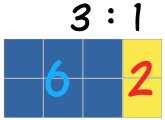Ratios
A ratio compares values.
A ratio says how much of one thing there is compared to another thing.

There are 3 blue squares to 1 yellow square
Ratios can be shown in different ways:
| Using the ":" to separate the values: | 3 : 1 | ||||
| Instead of the ":" you can use the word "to": | 3 to 1 | ||||
| Or write it like a fraction: |
|
A ratio can be scaled up:

Here the ratio is also 3 blue squares to 1 yellow square,
even though there are more squares.
Using Ratios
The trick with ratios is to always multiply or divide the numbers by the same value.
Example:
4 : 5 is the same as 4×2 : 5×2 = 8 : 10
|  |
Recipes
Example: A Recipe for pancakes uses 3 cups of flour and 2 cups of milk.
So the ratio of flour to milk is 3 : 2
If you needed to make pancakes for a LOT of people you might need 4 times the quantity, so you multiply the numbers by 4:
3×4 : 2×4 = 12 : 8
In other words, 12 cups of flour and 8 cups of milk.
The ratio is still the same, so the pancakes should be just as yummy.
"Part-to-Part" and "Part-to-Whole" Ratios
The examples so far have been "part-to-part" (comparing one part to another part).
But a ratio can also show a part compared to the whole lot.
Example: There are 5 pups, 2 are boys, and 3 are girls
 |
Part-to-Part:
The ratio of boys to girls is 2:3 or 2/3
The ratio of girls to boys is 3:2 or 3/2
Part-to-Whole:
The ratio of boys to all pups is 2:5 or 2/5
The ratio of girls to all pups is 3:5 or 3/5
|